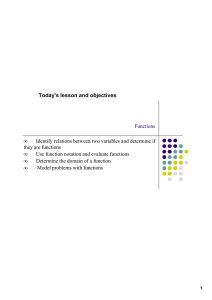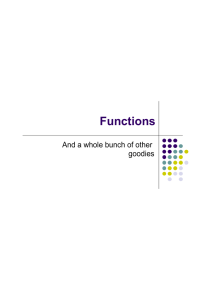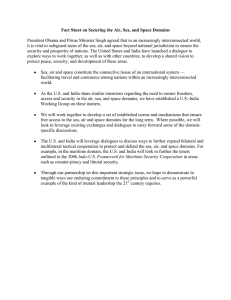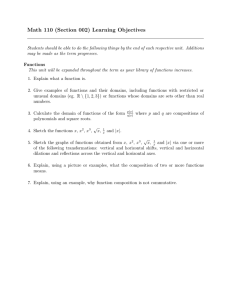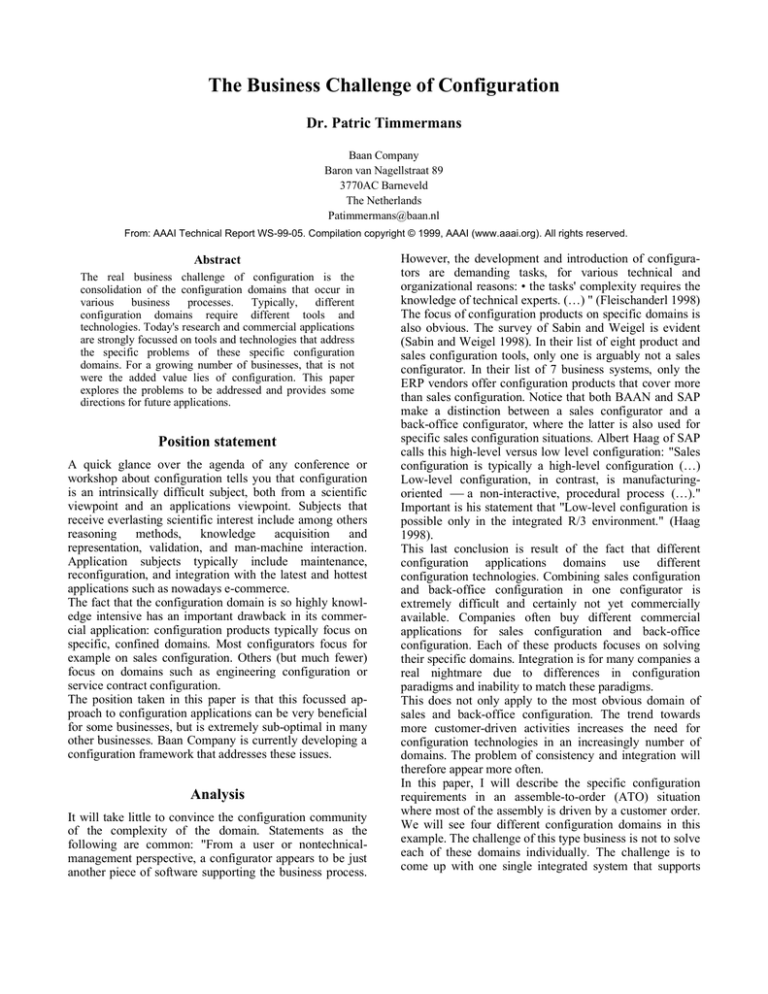
The Business Challenge of Configuration
Dr. Patric Timmermans
Baan Company
Baron van Nagellstraat 89
3770AC Barneveld
The Netherlands
Patimmermans@baan.nl
From: AAAI Technical Report WS-99-05. Compilation copyright © 1999, AAAI (www.aaai.org). All rights reserved.
Abstract
The real business challenge of configuration is the
consolidation of the configuration domains that occur in
various
business
processes.
Typically,
different
configuration domains require different tools and
technologies. Today's research and commercial applications
are strongly focussed on tools and technologies that address
the specific problems of these specific configuration
domains. For a growing number of businesses, that is not
were the added value lies of configuration. This paper
explores the problems to be addressed and provides some
directions for future applications.
Position statement
A quick glance over the agenda of any conference or
workshop about configuration tells you that configuration
is an intrinsically difficult subject, both from a scientific
viewpoint and an applications viewpoint. Subjects that
receive everlasting scientific interest include among others
reasoning methods,
knowledge
acquisition
and
representation, validation, and man-machine interaction.
Application subjects typically include maintenance,
reconfiguration, and integration with the latest and hottest
applications such as nowadays e-commerce.
The fact that the configuration domain is so highly knowledge intensive has an important drawback in its commercial application: configuration products typically focus on
specific, confined domains. Most configurators focus for
example on sales configuration. Others (but much fewer)
focus on domains such as engineering configuration or
service contract configuration.
The position taken in this paper is that this focussed approach to configuration applications can be very beneficial
for some businesses, but is extremely sub-optimal in many
other businesses. Baan Company is currently developing a
configuration framework that addresses these issues.
Analysis
It will take little to convince the configuration community
of the complexity of the domain. Statements as the
following are common: "From a user or nontechnicalmanagement perspective, a configurator appears to be just
another piece of software supporting the business process.
However, the development and introduction of configurators are demanding tasks, for various technical and
organizational reasons: • the tasks' complexity requires the
knowledge of technical experts. (…) " (Fleischanderl 1998)
The focus of configuration products on specific domains is
also obvious. The survey of Sabin and Weigel is evident
(Sabin and Weigel 1998). In their list of eight product and
sales configuration tools, only one is arguably not a sales
configurator. In their list of 7 business systems, only the
ERP vendors offer configuration products that cover more
than sales configuration. Notice that both BAAN and SAP
make a distinction between a sales configurator and a
back-office configurator, where the latter is also used for
specific sales configuration situations. Albert Haag of SAP
calls this high-level versus low level configuration: "Sales
configuration is typically a high-level configuration (…)
Low-level configuration, in contrast, is manufacturingoriented a non-interactive, procedural process (…)."
Important is his statement that "Low-level configuration is
possible only in the integrated R/3 environment." (Haag
1998).
This last conclusion is result of the fact that different
configuration applications domains use different
configuration technologies. Combining sales configuration
and back-office configuration in one configurator is
extremely difficult and certainly not yet commercially
available. Companies often buy different commercial
applications for sales configuration and back-office
configuration. Each of these products focuses on solving
their specific domains. Integration is for many companies a
real nightmare due to differences in configuration
paradigms and inability to match these paradigms.
This does not only apply to the most obvious domain of
sales and back-office configuration. The trend towards
more customer-driven activities increases the need for
configuration technologies in an increasingly number of
domains. The problem of consistency and integration will
therefore appear more often.
In this paper, I will describe the specific configuration
requirements in an assemble-to-order (ATO) situation
where most of the assembly is driven by a customer order.
We will see four different configuration domains in this
example. The challenge of this type business is not to solve
each of these domains individually. The challenge is to
come up with one single integrated system that supports
the business process. Notice that this situation is only one
of many possible examples and many more domains are
identified as well. Other situations include Make-to-Order
and Engineer-to-Order situations. Examples of domains
not mentioned in the example include Shop Floor Control,
Service, and Software Configuration.
The paper concludes with a paragraph explaining the key
features of a configuration framework that addresses this
business need. Baan Company is currently implementing
this framework.
Configuration Characteristics
assembly line conf.
process planning
in
ma
Do
engineering
sales configuration
Configuration hierarchy
In this chapter we explore the characteristics of four
different configuration domains based on a real-world
example of an assemble-to-order (ATO) case. Businesses
that are of this nature include high volume, line assembly
businesses such as for example the car industry, truck
industry, aircraft industry, industrial air-conditioning
system industry and high volume machine tools industry.
The figure below illustrates the four configuration domains
that are used in this case description:
• Sales configuration
• Engineering configuration
• Assembly line configuration
• Process Planning
The vertical bars in the figure represent configuration
hierarchies. For example, the top of the engineering bar
refers to a small catalog of products that engineering offers
to sales while the bottom of the engineering bar refers to
the complete catalog of thousands of parts that are
specified by engineering to actual manufacture and
assemble the product.
Domain
The arrows between the bars indicate relationships
between configuration domains. For example, a sales
configuration will have to be based on an engineering
configuration and has to include a reference to the
assembly line the product will be assembled.
Following paragraphs will explore each domain in more
detail and will address the specific configuration challenges including the relationships between configuration
domains.
Sales configuration
Functionality in relation to integrations
• Product configuration
• Available-to-Promise checks (ATP); available-topromise is the function to check if the configured
product can actually be delivered to the customer in the
specified configuration and delivery time. Two different
types of ATP are used in the assemble-to-order (ATO)
business: option based ATP and assembly part ATP.
Option based ATP is a check on the selected options (we
still can produce 6 trucks with the option heavy-duty),
while assembly part ATP requires a bill-of-material
explosion to determine if the critical parts in the selected
configuration are in stock or ordered.
• Order completion: the sales office has to add
information to the order for processing purposes. In an
international, multi-site case, this includes assigning the
order to an assembly/manufacturing facility. Sales
offices are often uniquely assigned to specific facilities,
but this is not common.
• Forecasting; production and assembly forecasts are often
based on both a top-down global market analysis and a
bottom-up sales forecast. The challenge is how to define
forecasts on configurable products, and how to
aggregate these into global forecasts. And what are the
consequences for the assembly facilities? For example:
the global forecast includes 30% left-hand drive vehicles
versus 70% right-hand and 20% heavy-duty versus 80%
light-duty. Assembly facilities provide capacity for 5%
heavy-duty left-hand vehicles. Is this sufficient? The
challenge is therefore to use the critical option
combinations for manufacturing and assembly in the
sales forecast, taking into account that these will change
over time and that the combinations may not even make
sense for a sales department.
Configuration technologies required. Configuration
technologies required are 'classic': interaction between the
sales person and the configurator (the system), constraints/
rule based reasoning, constraints management, explanation
of constraints, optimization, consistency and completeness
of a configuration, complete deduction, graceful degradation, reconfiguration, et cetera (Skovgaard 1995) (Yu,
Skovgaard 98).
Integration challenges. Some of the integration
challenges are easy to deduct from the above paragraph on
functionality: how to provide ATP and forecasting
information to "the back-office".
A bigger challenge is how to map the product models that
are defined by engineering to the product models that are
used in a sales situation. This can be trivial if the modules
defined by engineering are the same as used in the
perception of the customer. For example, when configuring
a kitchen, engineering develops stoves, cabinets, sinks, et
cetera. A customer configures stoves, cabinets, sinks, et
cetera.
In many cases however, engineering models differ
drastically from the sales models of a product. For
example, a truck in engineering consists of 6000 assembly
parts that aggregate into a chassis, powertrain, body, et
cetera. The customer however is interested in freight
capacity, cost efficiency, and usability. This mapping is not
trivial. Moreover, do you want to include all engineering
parts in the sales configurator? How to deal with
constraints defined in the engineering model?
challenges with sales and process planning is discussed in
separate paragraphs and considered right or not as
challenges for sales and process planning rather than
challenges for engineering.
Assembly line configuration
Functionality. The complexity of modern assembly lines
lies in the fact that they have to support the assembly of a
Engineering configuration
huge variety of products. Fine-tuning a line is no longer a
one-off activity, but a continuous activity, based on the
Functionality. Key functionality in engineering is the
actual load (combination of products being assembled) of
modeling of a product in engineering structures. These
the assembly line. Furthermore, the assembly line
engineering structures include the specification of
configuration is used for planning purposes. This includes
configurable and standard items, their relationships and
long term forecasts as well as short term available-toconstraints.
promise logic based on combinations of line configuration,
generic items line offset times, and work loads.
(configurable items)
The fact that production planning and process planning use
different line configurations increases complexity. One
engineering configuration is used to define what parts are needed at
modules
what time; the other is used to define what resources
(machines, tools, people) are needed when. Often multiple
assembly lines are scheduled simultaneously.
engineering Configuration and Integration challenges. The key
subassemblies
challenge is to build a model of the assembly line that can
be used by all planning processes. Technologies needed for
Assembly Parts
this include constraints management, version control,
change order control, effectivity and expiry control.
The engineering structure in the assembly industry is often
composed of configurable items and 'standard' Bill-ofMaterials. While the top level in the engineering structure
consists of configurable items, at the lower levels one will
find standard bills-of-material: engineering modules.
Examples of engineering modules in the truck industry are
braking systems, electrical systems, and powertrains. Note
that these modules often do not appear in the sales
configurator.
The need for these specific engineering structures is to
simplify both engineering and production planning.
Imagine the calculations needed for the parts requirements
planning of 10,000 cars each consisting of 6000 parts if the
bill-of-material of each car has to be exploded into its
parts. Typically, there is simply not sufficient computer
power available to process this in the available time. Much
easier is to define standard engineering modules, calculate
the number needed of each module and explode each
module only once.
Configuration technologies required and Integration
challenges. Configuration technologies needed are often
much different from sales configuration: constraints
management, consistency and completeness of a model,
version control, change order control, effectivity and
expiry control, multi-user modeling.
Integration challenges in engineering often relate to
integrations with Product and Engineering Data
Management systems, CAD systems, et cetera. This is
outside the context of this example case. Integration
Process Planning
Functionality. The process planner defines what
components in the engineering structure are the assembly
parts that will be supplied to the line. This can be different
per line! 600 different suppliers is not unusual for one
assembly line in the automotive industry.
Process planning is the process of defining tasks and
operations that specify the relationships between assembly
parts, configurable engineering items, assembly lines,
tools, machines and people. These relationships can be
constraints and time dependent. A process planning model
of a product (i.e. the assembly model) differs from the
engineering model: the engineering model specifies how a
product looks like from a form-fit-function point of view.
The assembly model specifies how the product can be
assembled. For example, the electrical system and break
system of a truck can be two different engineering
modules. In assembly, the dashboard will be a module,
which includes both electrical and break 'components'.
Business processes that are directly related to process
planning include the 'solve process' or 'final assembly
planning'. The purpose of the solve process is to calculate
time-phased assembly part requirements for pseudo orders
and sales orders. Long-term parts requirements are often
calculated based on the engineering structures. Short-term
parts requirements have to take process-planning
configurations and line configurations into consideration.
ATP requests that originate in the sales configuration are
often executed by process planning.
Providing each of the above configuration domains with
appropriate configuration tools and technologies is a big
challenge. Even a bigger challenge however is to keep the
models between these domains consistent. Just to mention
a few touch points:
1. Configurable sales items are derived from engineering
items including constraints.
2. Configurable engineering items are related to lines; e.g.,
for assigning orders to lines.
3. Assembly parts are related to lines or line segments for
parts requirements planning and assembly order
generation.
4. Assembly parts are for assembly order generation indirectly (via process planning) related to line stations.
5. Process planning items are related to assembly line
segments.
6. Assembly operations are allocated to line stations.
7. Process planning items are related to configurable
engineering items.
8. Assembly operations are related to assembly parts.
Configuration Framework
The goal of this paper is to address the need for a
configuration framework that covers the business need of
an integrated configuration solution across the business
process. Such framework is not available today. It is not
the intention of this paper to specify in any detail how such
configuration framework would look like. Based on the
case described in this paper, we can however identify some
key characteristics.
• One common modeling language supporting different
models
• One constraints solver logic embedded in all
configuration solutions
• Various modeling tools for various application domains
• Various user interfaces for various application domains
I conclude this paper with a short exposé about the need for
supporting models in the modeling language.
Different functions different models. For different
domains, such as engineering, manufacturing, assembly,
marketing, it is often more practical to specify different
configuration models than to specify views.
Each function has its own configuration model and
components. The configuration components of different
functions can be related through inheritance and dependency relationships. These relationships guarantee the passing
of information between models. The product specification
Engineering model
Example relationships between these
configuration domains
can be passed from one model to the other through dependency relationships and the properties of the components.
The inheritance and dependency relationships between
components in different models have to be specified such
as to guarantee the transfer of a complete configuration.
transmission emission
{transmission-type} {emission}
engine
{engine-volume;
engine-type}
front panel
{color}
frame
{color}
powertrain
body
{engine-type, transmission-type,
emission, engine volume}
{color}
truck {color, engine-type, transmission-type
emission, engine volume}
Sales model
Configuration and Integration challenges. The key
challenge is to maintain a model that links the configurable
engineering items to assembly parts, assembly lines, tools,
machines and people. This model will be used by complex
planning algorithms. Change management and efficiency
are therefore key properties of the configuration system.
truck {color, engine-type, transmission-type
emission, engine volume}
The sales model in this example consists of one
configuration component ‘truck’ which has an inheritance
relationship with the engineering component ‘truck’.
Notice that the component truck in the engineering model
can be different from the component car in the sales model,
even though the name and the properties are the same; the
properties of the engineering component truck are inherited
by the sales component truck.
An example is the passing of product variants (instances)
from a sales model to an engineering model. This process
is referred to as 'sales solve'. A sales solve can be implemented by specifying a 'sales relationship' between the
truck in the sales model and the truck in the engineering
model. A general purpose solve method will translate a
product variant of the sales truck to a product variant of
engineering truck using the user-defined 'sales
relationship', taking into account constraints from both
sales and engineering.
References
Fleischanderl et al. 1998. Configuring large systems using
generative constraint satisfaction. IEEE Intelligent Systems
& their applications. July/August.
Haag, Albert 1998. Sales configuration in business
processes. IEEE Intelligent Systems & their applications,
July/August.
Sabin, Daniel; Weigel, Rainer 1998. Product Configuration
Frameworks - A Survey. IEEE Intelligent Systems & their
applications. July/August.
Skovgaard, H.J. 1995. A New Approach to Product Configuration. In Proceedings of the Third International Conference ilce’95, Paris. ISBN 2-9509096-0-4. 197-204.
Yu, B.; Skovgaard, H.J. 1998. A configuration Tool To
Increase Product Competitiveness. IEEE Intelligent Systems. 13/ 4. July-August.


